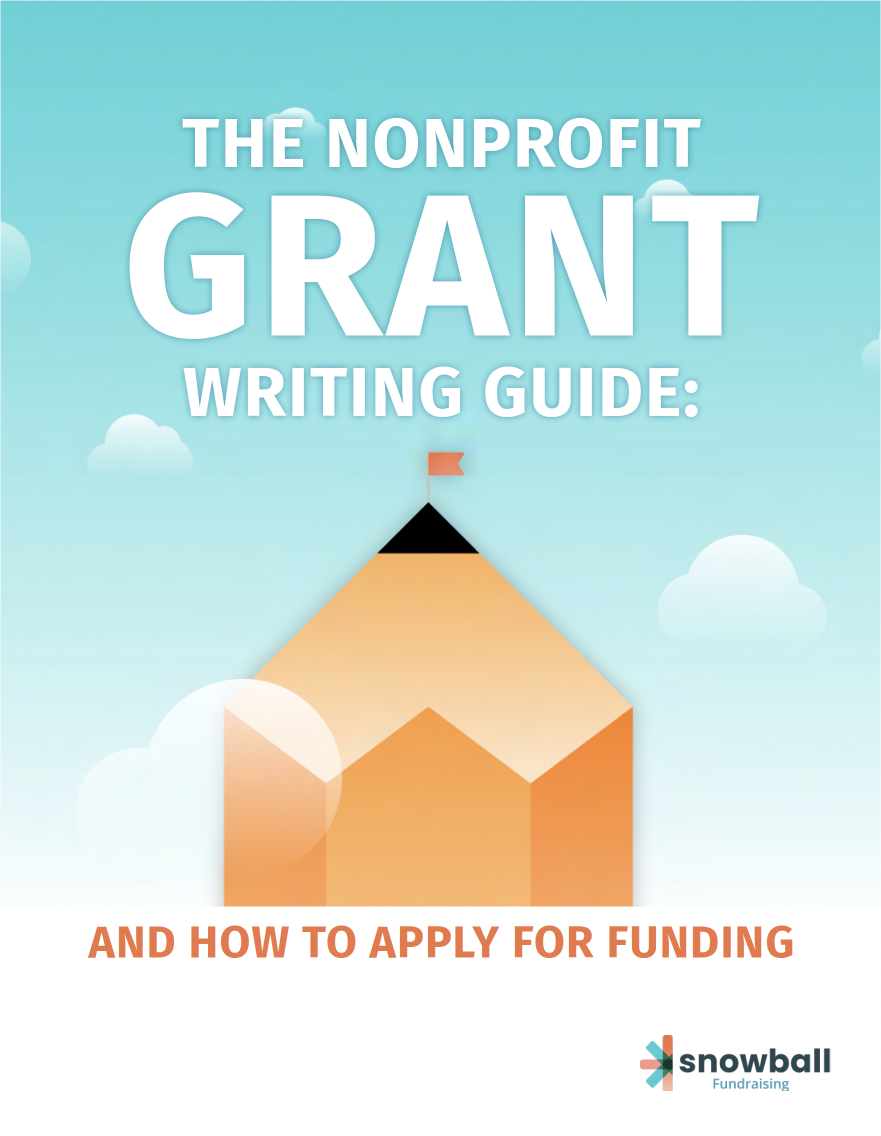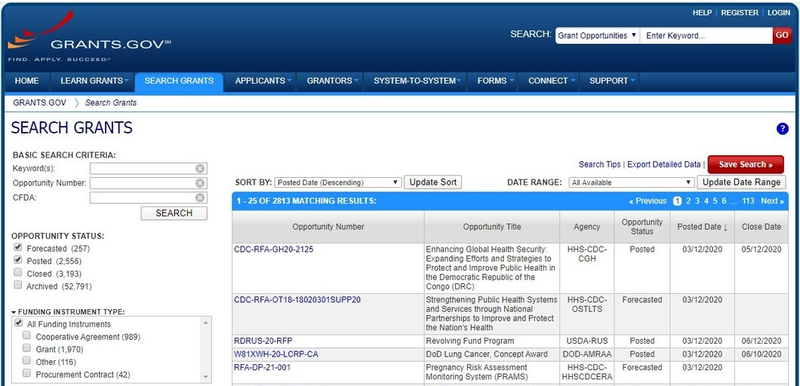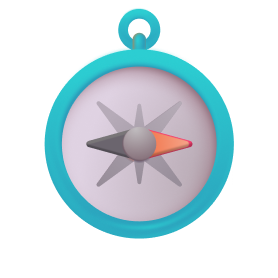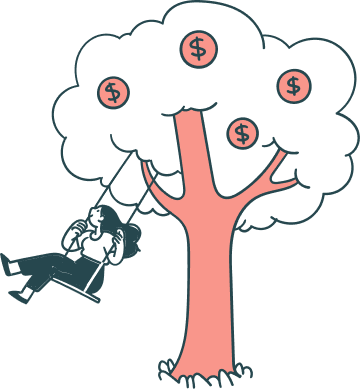
💰Improve your grant writing and double your funding.
Inside: Basics of Grant Writing, Effective Components of Grant Proposals, Finding Grant Opportunities, Strategy
Is your nonprofit interested in some free funding for large projects and goals?
Of course, you are!

Grant writing for nonprofits can be one of the most challenging yet rewarding components of one’s philanthropic career. When done well, it gives your nonprofit the resources to achieve its goals. Although competition for major grants can be intimidating and the writing process time-consuming, the good news is that with a few solid tips, you’ll be on your way to successful funding.
By following a handful of basic best practices and acquainting yourself with the grant writing process, you can drastically increase the chance that your organization’s grant application will attract attention. Explore this guide to nonprofit grant writing as we walk through an overview of the entire process, plus some helpful tips and resources. Here’s what we’ll cover:
- Understanding the Basics of Grant Writing for Nonprofits
- Finding the Right Nonprofit Grant Opportunities
- Components of an Effective Nonprofit Grant Proposal
- Building a Case for Your Nonprofit Grant
- Refining Your Strategy & Completing Your Application
Remember— successful grant writing for nonprofits takes focus and dedication, so it’s important to understand the process as soon as possible. Use this article as a reference to guide your grant writing and make sure your team doesn’t lose sight of the big picture. Let’s get started!
1.
Understanding the Basics of
Grant Writing for Nonprofits
Grants are packages of structured financial support for specific projects offered by grant-giving organizations. To be considered for one, you have to complete an application and make solid case for support.
Grant writing has fantastic potential to help your nonprofit achieve its mission. A grant that supports a major new project can represent the beginning of a new phase of growth for your nonprofit and attract increased attention and new donors.
But it does take time and labor to write and submit grant proposals. Applying for grants is hard work, and many come with strings attached, such as parameters surrounding the allocation of funds. Plus, you may be going up against several other qualified organizations for limited funding.

So how do you get these coveted grants? Grant-giving organizations tend to seek candidates that:
- Have clearly definable and relevant missions.
- Are driven by specific project goals and plans.
- Maintain adequate financial and operational structures.
- Use modern fundraising tools and methods.
- Possess a history of successful projects and initiatives.
- Retain strong relationships with community and peers.
This means that your organization should already have a strong vision and smart operational foundations. Grant-giving organizations won’t fund a nonprofit that they don’t think will last. Show them yours has staying power with solid backing from non-grant sources as well.
As a rule of thumb, fundraising experts recommend around 20% of your total funding to be grant-based— with the majority coming from other fundraising sources. For example, implementing a free online donations platform lets anyone give to your nonprofit, whether they’re from a grant-providing institution or not.

Pro Grant Writing Tip #1
Understand the amount of work required before starting.
Since grant funds usually represent a significant amount of money for the bodies or foundations that distribute them, whichever organizations ultimately receive the funding must prove that their operations are worthwhile, sustainable, and practical. This is typically done through a considerable amount of written material in the form of applications and proposals. Check out this free grant proposal template that walks through each of the crucial components of a winning grant proposal.
2.
Finding the Right
Nonprofit Grant Opportunities
As you begin the grant writing process, it’s important to use your goals to guide your grant search so that the grants you pursue will already be fairly aligned with your mission. By investing your time and effort in these opportunities, you’ll drastically increase your odds of success.
So, where can you find these grants? The most common sources for nonprofit grants include:
- Federal grant programs and endowments
- State and municipal-funded resources
- Corporate giving programs
- Private grant-giving foundations
Begin your search with an exploration of federal- and state-level grant databases. Grants.gov is a great starting point— a comprehensive database compilation of all available federal grants that can be filtered by source, category, and eligible organizations.


Even if you don’t find a federal grant appropriate for your exact mission, the database will give you a better understanding of available grants. Once you find a grant to pursue, start researching its source and see where to go from there!
Alternatively, if you’re looking for grants to help you promote your nonprofit, consider looking into Google Ads grants. These in-kind donations of up to $10,000 in monthly Google Ads funding can put your ads at the top of search queries and attract new supporters when you manage your Google Grants efficiently.

Pro Grant Writing Tip #2
Once you find the right grant, tailor your plan to that specific opportunity.
When you identify a particular grant whose description matches the main concern of your organization’s project, research the grant’s source— including its giving history, leadership, and mission. Then, align the angle of your grant proposal with whatever you learn about the foundation.
3.
Components of an
Effective Nonprofit Grant Proposal
Make sure you understand the components of a typical nonprofit grant proposal. You can find more complete explanations of each section in our proposal template, but these are the basic parts of a grant application:
- Cover letter: Briefly introduce yourself, your organization, and your proposal to the grant-providing institution.
- Executive summary: Quickly explain the most crucial aspects of your proposal, such as necessity, background, and relevance.
- Statement of need: Clearly define the problem that you hope to solve with grant funding. A sense of urgency and authority is key!
- Goals and objectives: Establish goals directly related to the need you defined, using quantifiable objectives and budgets.
- Methods and strategies: Layout a tangible, feasible plan to follow through with each step of your proposed program.
- Plan of evaluation: Set up a plan to track your progress and evaluate whether goals are being met throughout the entire timeline.
- Budget projections: Create a detailed budget covering expenses such as personnel, supplies, and overhead costs.
- Organization information: Provide insights into your organization’s history, staff, and goals.
Note that some, but not all, grant-giving foundations might require an initial letter of intent and proof of support from other stakeholders as well.
Grant writing for nonprofits requires that you already understand your project’s core goals before even thinking about completing a proposal. Even if you’re unsure of your exact engagement plans or marketing strategies, it’s a good idea to start any new project by clearly defining your goals.
Consider specific concerns and benefits to your community, as well as a solid strategy for gathering support and engagement. With concrete goals and a solid mission at the top of mind, you can begin to identify more specific strategies, tools, and stakeholders for your project.

Pro Grant Writing Tip #3
Write your grant proposal clearly and boldly.
Another great way to bolster your case for support in your grant application is to provide some concrete stories of your organization’s impact in your community. Make sure your language is descriptive and specific, but concise and focused. Relevant data and smart insights should do the convincing, not the length or vocabulary of your proposal.
4.
Building a Case for
Your Nonprofit Grant

Think of grant writing for nonprofits as simply pitching your idea. With a strong internal team of dedicated professionals, you’ll be able to build a solid case for support by explaining why your plans are both meaningful and achievable.
The point of your proposal is to convince an agency or foundation that your organization is a responsible steward of funds, driven by an actionable mission, and engaged with supporters in impactful ways.

Building a Nonprofit Grant Writing Team
Strong grant writing abilities require multiple perspectives to ensure that your programming plans, language and data are the most persuasive and well-reasoned that they can be. It’s seldom a good idea to write a grant application alone.
Your nonprofit’s grant writing team should be involved in brainstorming the right programming and engagement strategies to propose. A reliable team will consist of:
- Your nonprofit’s executive leadership (at least for oversight!)
- At least one board member
- Staff members, especially those familiar with fundraising and project planning
- Volunteers who can offer unique perspectives on engagement
Keep the team to five or six members at a maximum. Too many voices can create distractions, reduce focus, and slow the entire grant writing process. Most importantly, prioritize diverse perspectives on your grant writing team to strengthen your appeal and create a more robust and flexible plan.
An effective grant writing team will help your project goals and strategies remain fully actionable and properly scaled to the grant’s scope. Each team member can offer unique insights into the grant writing process to craft the most successful proposal possible.
Your organization’s passion for its mission is certainly half of the equation here. Still, data is often the deciding factor for grant-giving bodies, especially those receiving tons of applications from nonprofits around the world.
Depending on the focus and scope of your project, consider compiling data such as:
- Fundraising statistics from your donations platform
- Analytics and engagement trends from your CRM
- Your nonprofit’s financial records
- Sociological or economic data concerning the key issue
- Other data illustrating your work and community involvement
The best cases for support provide a concrete background built on a combination of purpose and statistics. Balance your emotional appeal with quantitative plans and data, highlighting the engagement methods that have brought your nonprofit success in the past.

Here’s an example template of a case for support to better understand what goes into this aspect of the grant writing process.
The need for our Nonprofit Organization Programming Project is great.
Our community has struggled with _____ for several years, and its effects have been amplified by the rise of _____, changes in _____, and the loss of _____. Statistics show that this issue is on the rise in communities like ours:
- Properly cited statistics from an authoritative source
The Nonprofit Organization has confronted this issue in the past, and other local groups and governing bodies have addressed it as well, but we believe a more coordinated effort with greater support will solve the issue.
- Timeline of the issue in your community and any past outreach initiatives, legislation, etc.
If our Programming Project is not implemented, the community is at risk of _____. Our expertise and background in _____, as well as out local partnerships with _____, place the Nonprofit Organization in a unique position to make a major difference.
Be sure to establish clear data reporting protocols across operations at an early stage. Your fundraising, accounting, marketing, and management tools should all cleanly and automatically provide detailed reports, which will reward your current and future grant writing efforts.
Be sure to research and collect any data relevant to the root issues driving your project’s mission and affecting your community. This data-driven practice makes the grant writing process easier by backing any claims about your work and past successes and allowing you to make insightful connections that could win you the grant.

Pro Grant Writing Tip #4
Keep your data and resources organized and accessible.
A successful nonprofit grant application must make a strong case for support. A winning nonprofit backs up its plans with effective and powerful data to present your organization as a professional, efficient, and responsible steward of funds. Grant officers might appreciate and champion your nonprofit’s plans to enrich its community, but only persuasive and illustrative data can fully justify the decision to give major support like a grant.

Take a Personalized Tour
Schedule a demo with one of our fundraising consultants. We’ll show you how the Snowball platform has benefited other nonprofit organizations, and how it can help you.
5.
Refining Your Strategy &
Completing Your Application

Remember that your strategy will adapt and change as you move through the grant writing process. Completing your application without adjusting your programming plans or shifting your goals at all typically means that your strategy could stand to be strengthened.
Establishing a peer review system is an excellent way to identify issues in both your rationale and the writing itself. After all, discovering any weak links now means they can be addressed before the grant program officer reviews the application later.
One effective way to ensure that your grant proposal remains focused and impact-driven is to identify how your project will provide a return on investment. Make sure to keep a focus on:
- A literal return on investment. Prove that your project will reach a quantifiable threshold of success, such as a specific engagement rate or funds raised at events.
- A community return on investment. Explain the less tangible but still substantial positive impact your project will have on your community.
Another key strategy for keeping your grant writing strategy flexible is to field thoughts from key stakeholders. What kinds of projects do your volunteers, donors, constituents, and members think would be perfect for your organization to undertake?
Your organization’s leadership will need to approve your final proposal anyway, so why not invite them to provide thoughts and feedback during the writing process? They could quickly recognize weaknesses or opportunities that your team might have missed.
The most common approach to writing a grant involves your team assigning individual members specific application sections to complete in a collaborative online document. This enables your team to establish an efficient editing process. You can easily ensure that each section is examined both individually and in the context of the sections before and after it. Stay on the lookout for spelling and grammar mistakes, ineffective language, and unsupported claims.
And don’t forget, your organization is part of a community—which includes other nonprofits. If another nonprofit receives the grant, remember that the funding is still going toward bettering your community in important ways. You’ll have other funding opportunities, whether through different grants, online giving, or major gifts from high-value donors, or corporate support from local businesses.
Upon completion, make sure the entire grant proposal is reviewed multiple times. Once the team is pleased with the application and your nonprofit’s leadership signs off, it’s time to send it off! Depending on the grant’s source, you may submit your application electronically or through the mail— be sure to check well in advance of the due date.

Pro Grant Writing Tip #5
Don’t be afraid to get personal!
Personally reaching out to the funding body is a good idea at times. Calling, writing, or meeting with the grant’s program officer can be a good idea to discuss the alignment of your ideas and the priorities of the grant-giving body, but never contact the grant officer simply to make an impression. Some grant-giving organizations will explicitly ask not to be contacted, so just make sure to check in advance.
Grant writing for nonprofits is serious business, and by approaching it with careful planning and belief in the value of your work, you can write a successful proposal. You’ve started on the right foot by reading through this guide to writing a winning nonprofit grant proposal, but be sure to do as much research as you can.
Acquiring the perfect grant is certainly a challenge, but the rewards can be immense. As you prepare to start the grant writing process for your nonprofit, we wish you the best of luck! Just be sure your organization doesn’t become too fixated on grant writing and lose sight of other key nonprofit operations.
No matter what happens, preparing for, writing, and submitting your grant application will give you greater insights into your organization than you’ve ever had before. You’ll be even more set up for success!
For more information on grant writing for nonprofits and securing other sources of funding, be sure to check out these additional resources:
- Grant Proposal Template. Our guide to any winning grant proposal’s essential components can give you a handy checklist for your own grant writing process!
- Top Volunteer Grant Companies. If your organization features an active volunteer program, these corporate philanthropy programs are another great way to fund your mission!
- 5 Types of Nonprofit Startup Grants. New nonprofits can apply for startup grants for initial funding. Learn more with our quick guide.
- Best Nonprofit Software to Raise Money Fast. Don’t wait around for the grant. Take action to raise funds now by building a solid fundraising toolkit.
- Fundraising Letter Templates. Check out this exhaustive resource of templates. Information solicitations and requests for letters of support are often necessary when grant writing.





